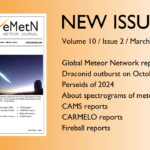Roberto Gorelli points our attention at a recently published meteor paper.
Meteor Shower Modeling: Past and Future Draconid Outbursts
This paper has been submitted to Elsevier for publication by A. Egal, P. Wiegert, P. G. Brown, D. E. Moser, M. Campbell-Brown, A. Moorhead, S. Ehlert and N. Moticska.
Abstract: This work presents numerical simulations of meteoroid streams released by comet 21P/Giacobini-Zinner over the period 1850-2030. The initial methodology, based on Vaubaillon et al. (2005), has been updated and modified to account for the evolution of the comet’s dust production along its orbit. The peak time, intensity, and duration of the shower were assessed using simulated activity profiles that are calibrated to match observations of historic Draconid outbursts. The characteristics of all the main apparitions of the
shower are reproduced, with a peak time accuracy of half an hour and an intensity estimate correct to within a factor of 2 (visual showers) or 3 (radio outbursts). Our model also revealed the existence of a previously unreported strong radio outburst on October 9 1999, that has since been confirmed by archival radar measurements. The first results of the model, presented in Egal et al. (2018), provided one of the best predictions of the recent 2018 outburst. Three future radio outbursts are predicted in the next decade, in 2019, 2025 and 2029. The strongest activity is expected in 2025 when the Earth encounters the young 2012 trail. Because of the dynamical uncertainties associated with comet 21P’s orbital evolution between the 1959 and 1965 apparitions, observations of the 2019 radio outburst would be particularly helpful to improve the confidence of subsequent forecasts.
You can download this paper for free: https://arxiv.org/pdf/1904.12185.pdf (32 pages).
Older meteor library news:
2019
- Meteoroid structure and fragmentation, by M. D. Campbell-Brown. (24 March 2019).
- Solar cycle variation in radar meteor rates, by M. D. Campbell-Brown. (26 February 2019).
- A New Meteoroid Model, by Valeri V. Dikarev, Eberhard Grün, William J. Baggaley, David P. Galligan, Markus Landgraf, Rüdiger Jehn. (12 February 2019).
- Lunar impacts, by Costantino Sigismondi. (12 February 2019).
- Lunar impact flashes, by C. Avdellidou and J. Vaubaillon. (10 February 2019).
- The Geminid parent body: (3200) Phaethon, by Patrick A. Taylor, Edgard G. Rivera-Valentín, Lance A.M. Benner, Sean E. Marshall, Anne K. Virkki, Flaviane C.F. Venditti, Luisa F. Zambrano-Marin, Sriram S. Bhiravarasu, Betzaida Aponte-Hernandez, Carolina Rodriguez Sanchez-Vahamonde and Jon D. Giorgini. (10 February 2019).
- Sun approaching asteroids and meteor streams, by Quanzhi Ye and Mikael Granvik. (10 February 2019).
2018
- Waiting to make an impact: A probable excess of near-Earth asteroids in 2018 LA-like orbits, by C. de la Fuente Marcos and R. de la Fuente Marcos. (18 December 2018).
- What mechanisms dominate the activity of Geminid Parent (3200) Phaethon?, by LiangLiang Yu, Wing-Huen Ip and Tilman Spohn. (6 November 2018).
- The Draconid meteoroid stream 2018: prospects for satellite impact detection, by Auriane Egal, Paul Wiegert, Peter G. Brown, Danielle E. Moser, Althea V. Moorhead and William J. Cooke (21 September 2018).
- Modeling the measurement accuracy of pre-atmosphere velocities of meteoroids, by Denis Vida, Peter G. Brown and Margaret Campbell-Brown (15 July 2018).
2017
- The Mayas and Eta Aquariids in AD 250-909, by J.H. Kinsman and D.J. Asher (31 July 2017).


